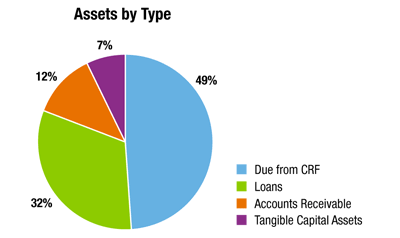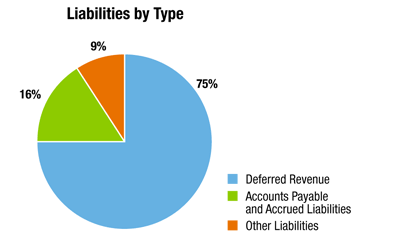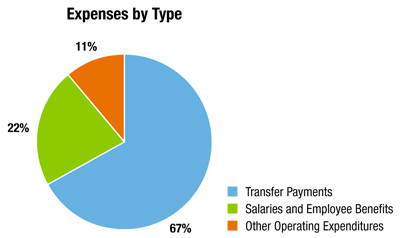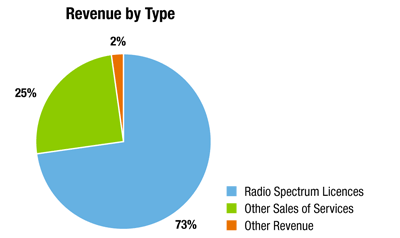Common menu bar links
Breadcrumb Trail
ARCHIVED - Industry Canada - Report
 This page has been archived.
This page has been archived.
Archived Content
Information identified as archived on the Web is for reference, research or recordkeeping purposes. It has not been altered or updated after the date of archiving. Web pages that are archived on the Web are not subject to the Government of Canada Web Standards. As per the Communications Policy of the Government of Canada, you can request alternate formats on the "Contact Us" page.
Section 3: Supplementary Information
3.1 Financial Highlights
The financial highlights presented within this DPR are intended to serve as a general overview of Industry Canada’s financial position and operations. The Department’s financial statements can be found on the Industry Canada website.
| Condensed Statement of Financial Position At March 31, 2010 |
($ thousands) | ||
|---|---|---|---|
| % Change | 2010 | 2009 (Restated*) | |
| Assets | |||
| Financial Assets | 62 | 1,431,810 | 881,680 |
| Non-Financial Assets | -7 | 101,421 | 109,505 |
| Total | 55 | 1,533,231 | 991,185 |
| Liabilities | |||
| Accounts Payable and Accrued Liabilities | 49 | 968,177 | 649,713 |
| Deferred Revenue | -12 | 4,376,729 | 4,957,325 |
| Other Liabilities | 6 | 524,242 | 495,521 |
| Total Liabilities | -4 | 5,869,148 | 6,102,559 |
| Equity | -15 | (4,335,917) | (5,111,374) |
| Total | 55 | 1,533,231 | 991,185 |
| Condensed Statement of Financial Operations For the period ended March 31, 2010 |
($ thousands) | ||
|---|---|---|---|
| % Change | 2010 | 2009 (Restated*) | |
| Expenses | |||
| Transfer Payments | 247 | 1,741,907 | 501,621 |
| Operating Expenses | 6 | 849,745 | 802,974 |
| Total Expenses | 99 | 2,591,652 | 1,304,595 |
| Revenues | |||
| Sales of Services | 43 | 1,103,940 | 771,734 |
| Other | -3 | 19,156 | 19,826 |
| Total Revenues | 42 | 1,123,096 | 791,560 |
| Net Cost of Operations | 186 | 1,468,556 | 513,035 |
Summary of 2010 Financial Results
The financial results presented in Industry Canada financial statements are shaped by the three strategic objectives that aim to help make Canadian industry more productive and competitive in the global economy, thus improving the economic and social well-being of Canadians.
In 2009–10, Industry Canada managed numerous stimulus grants and contributions projects through the EAP, which resulted in a significant increase in expenses from $1.28 billion in 2008–09 to $2.59 billion in 2009–10. The Government of Canada announced a set of initiatives aimed at providing a quick recovery from the economic downturn and improving access to financing, supporting small businesses, helping municipalities build stronger communities through investments in infrastructure, and providing short-term support for key industrial and commercial sectors.
Accounting changes
During the year, Industry Canada adopted the revised Treasury Board accounting policy regarding departmental financial statements. The first change in the accounting policy of Industry Canada is the recording of amounts due from the Consolidated Revenue Fund ($750 million in 2009–10) as an asset on the Statement of Financial Position. The purpose of this account is to record the cash Industry Canada will be able to draw from the Consolidated Revenue Fund in future years to meet some of its liabilities. The second change was the removal of Industry Canada’s investment in the Business Development Bank of Canada (BDC) and related dividend revenue. The removal of these accounts was performed since Industry Canada is not deemed to control the BDC. This is rather a responsibility of the Industry Portfolio under the Minister of Industry.
Assets
Total assets were $1.5 billion for 2009–10, an increase of $542 million (55%). The increase can be mostly attributed to the changes in accounting policy. There was also an increase in loans provided during the year for approximately $80 million. This can be partially attributed to the ITO, which provided loans through the SADI program to 8 companies in the Canadian aerospace and defence industry for R&D of new products and/or services that are expected to enhance the industry’s competitiveness in years to come. It can also be attributed to contributions through the Automotive Innovation Fund administered by Knowledge Advantage in Targeted Canadian Industries. A new agreement here was signed to support the development and commercialization of a wide range of powertrain components and modules with greater durability, less weight and higher quality. Accounts receivable grew by $90 million for amounts due from various organizations for radio licences unpaid under the Marketplace Frameworks and Regulations for Spectrum, Telecommunications and the Online Economy.
Liabilities
Total liabilities were $5.87 billion for 2009–10, a decrease of $219 million (4%). Accounts Payable increased by 50% this fiscal year, primarily a reflection of temporary increases to transfer payment programs for the EAP. An example of this would be entitlements to provinces under the Infrastructure Canada Program which are unpaid at March 31. Counteracting this change in payables was a decrease of $400 million in deferred revenue to radio spectrum licences sold in the 2GHz range, managed by the Marketplace Frameworks and Regulations for Spectrum, Telecommunications and the Online Economy. This decrease represents deferred spectrum auction revenue, which is recognized as earned revenue over a 10-year period.
Expenses
Total expenses were $2.59 billion in 2009–10, an increase of $1.28 billion (99%). The increase is mainly attributable to increased transfer payment expenses. The EAP provided Industry Canada with $1.41 billion in transfer payment program funding through various temporary transfer payment programs designed to help boost the Canadian economy. Recognized as expenses within the financial statements is $1.26 billion. Program delivery is reflected through the increase in these reported expenses and includes transfer payments for KIP ($2 billion over 2 years) under Canada’s Research and Innovation Capacity. This program was designed to enhance the infrastructure of Canadian colleges and universities. $1 billion in funding has been expensed in 2009–10 and is reflected in this increase to the reported transfer payment expense. The Community Adjustment Fund, under Community, Economic and Regional Development, expensed $116 million to address the short-term economic needs of Canadian communities impacted by the global recession. The Marquee Tourism Events Program, under Global Reach and Agility in Targeted Canadian Industries ($46 million), helps create jobs and increase tourism by enhancing annually recurring world-class events in Canada. In addition, FedDev Ontario delivered the Recreational Infrastructure Canada program ($30 million), a fund which helped renew and expand public recreation infrastructure in Canada.
Revenue
Total revenues were $1.12 billion in 2009–10, an increase of $332 million (42%). The majority of reported revenue in the departmental financial statements is attributed to the recognition of radio spectrum revenue managed by the Marketplace Frameworks and Regulations for Spectrum, Telecommunications and the Online Economy. The increase in this type of revenue reflects the recognition of radio spectrum auction licence fees received in prior fiscal years, particularly $4.26 billion received and deferred in 2008–09 for the 2GHz range. Other sales of services represent legislative fees and registrations through organizations such as Corporations Canada ($12 million), the Office of the Superintendent of Bankruptcy ($42 million), Competition Bureau ($23 million), and Measurement Canada ($1 million), which report under Marketplace Frameworks and Regulations.
3.2 List of Supplementary Information Tables Available Online
- Sources of Respendable and Non-Respendable Revenue
- User Fees Reporting
- Details on Transfer Payment Programs (TPPs)
- Details on Other Programs for Industry Canada
- Up-Front Multi-Year Funding
- Horizontal Initiatives
- Green Procurement
- Response to Parliamentary Committees and External Audits
- Internal Audits and Evaluations
3.3 Other Items of Interest Available Online
3.4 Additional Performance Results and Risk Analyses Available Online
- The Canadian Marketplace is Efficient and Competitive
- Science and Technology, Knowledge, and Innovation are Effective Drivers of a Strong Canadian Economy
- Competitive Businesses are Drivers of Sustainable Wealth Creation
- Indicators of Product Market Regulation, OECD 2008. (www.oecd.org/dataoecd/33/12/42136008.xls)
- The World Bank Group Ease of Doing Business Index, The World Bank, 2010. (www.doingbusiness.org/ExploreEconomies/?economyid=35)
- The Global Competitiveness Index, World Economic Forum, 2009-2010 (www.weforum.org/pdf/GCR09/Report/Countries/Canada.pdf )
- Exploring Canada’s Innovation Character: Benchmarking Against Global Best, Conference Board of Canada, 2004, p. 13-14. (www.conferenceboard.ca/e-Library/abstract.aspx?did=813)
- Main Science and Technology Indicators, OECD, 2009/2, p. 71.
- Main Science and Technology Indicators, OECD, 2009/2, p. 31.
- BCStats – Small Business Profile 2009: A Profile of Small Business in British Columbia, October 2009 Edition, p. 17. (www.bcstats.gov.bc.ca/data/bus_stat/busind/sm_bus/SBP2009.pdf)
- Industry Canada Key Small Business Statistics, 2009. (www.ic.gc.ca/eic/site/sbrp-rppe.nsf/eng/rd02406.html)
- Small Business Profile, Canadian Federation of Independent Business, October 2009, p.1. (www.cfib-fcei.ca/cfib-documents/rr3093.pdf)
- Statistics Canada: Canadian Business Patterns, December 2009, Available on CD-ROM.
- Indicators of Product Market Regulation, OECD 2008. (www.oecd.org/dataoecd/33/12/42136008.xls)
- The World Bank Group Ease of Doing Business Index, The World Bank, 2010. (www.doingbusiness.org/ExploreEconomies/?economyid=35)
- The Global Competitiveness Index, World Economic Forum, 2009-2010. (www.weforum.org/pdf/GCR09/Report/Countries/Canada.pdf)
- Exploring Canada’s Innovation Character: Benchmarking Against Global Best, Conference Board of Canada, 2004, p. 13-14. (www.conferenceboard.ca/e-Library/abstract.aspx?did=813)
- Main Science and Technology Indicators, OECD, 2009/2, p. 71.
- Main Science and Technology Indicators, OECD, 2009/2, p. 31.
- BCStats – Small Business Profile 2009: A Profile of Small Business in British Columbia, October 2009 Edition, p. 17. (www.bcstats.gov.bc.ca/data/bus_stat/busind/sm_bus/SBP2009.pdf)
- Industry Canada Key Small Business Statistics, 2009. (www.ic.gc.ca/eic/site/sbrp-rppe.nsf/eng/rd02406.html)
- Small Business Profile, Canadian Federation of Independent Business, October 2009, p.1. (www.cfib-fcei.ca/cfib-documents/rr3093.pdf)
- Statistics Canada: Canadian Business Patterns, December 2009, Available on CD-ROM.
- North American Industry Classification System (www.statcan.gc.ca/subjects-sujets/standard-norme/naics-scian/2002/naics-scian02l-eng.htm)
- Government of Ontario, Ministry of Finance, Economic Update, April 16, 2010.
- Government of Ontario, Ministry of Finance, Ontario Economic Accounts — Fourth Quarter 2009 Table 3, Ontario Real GDP.




